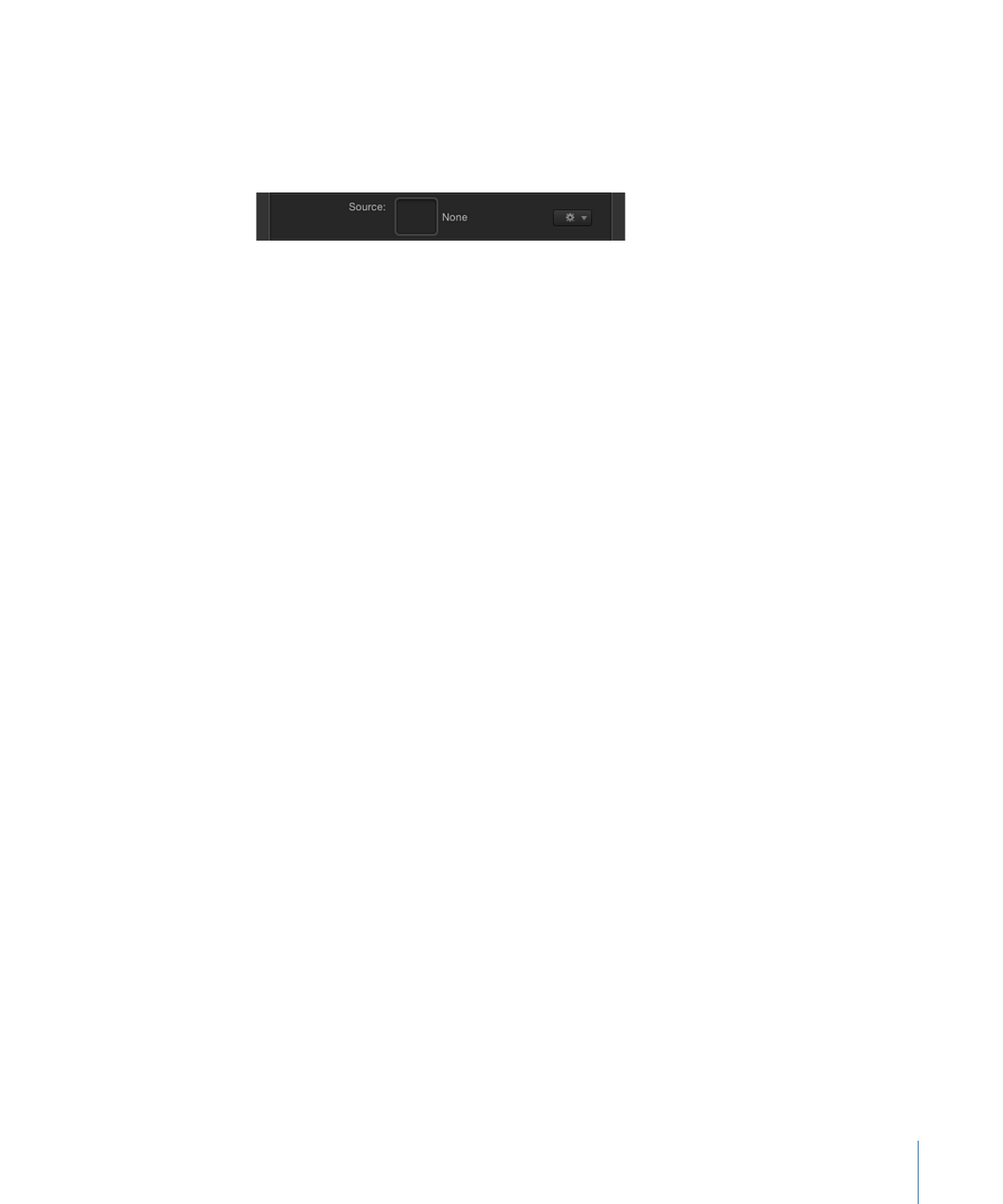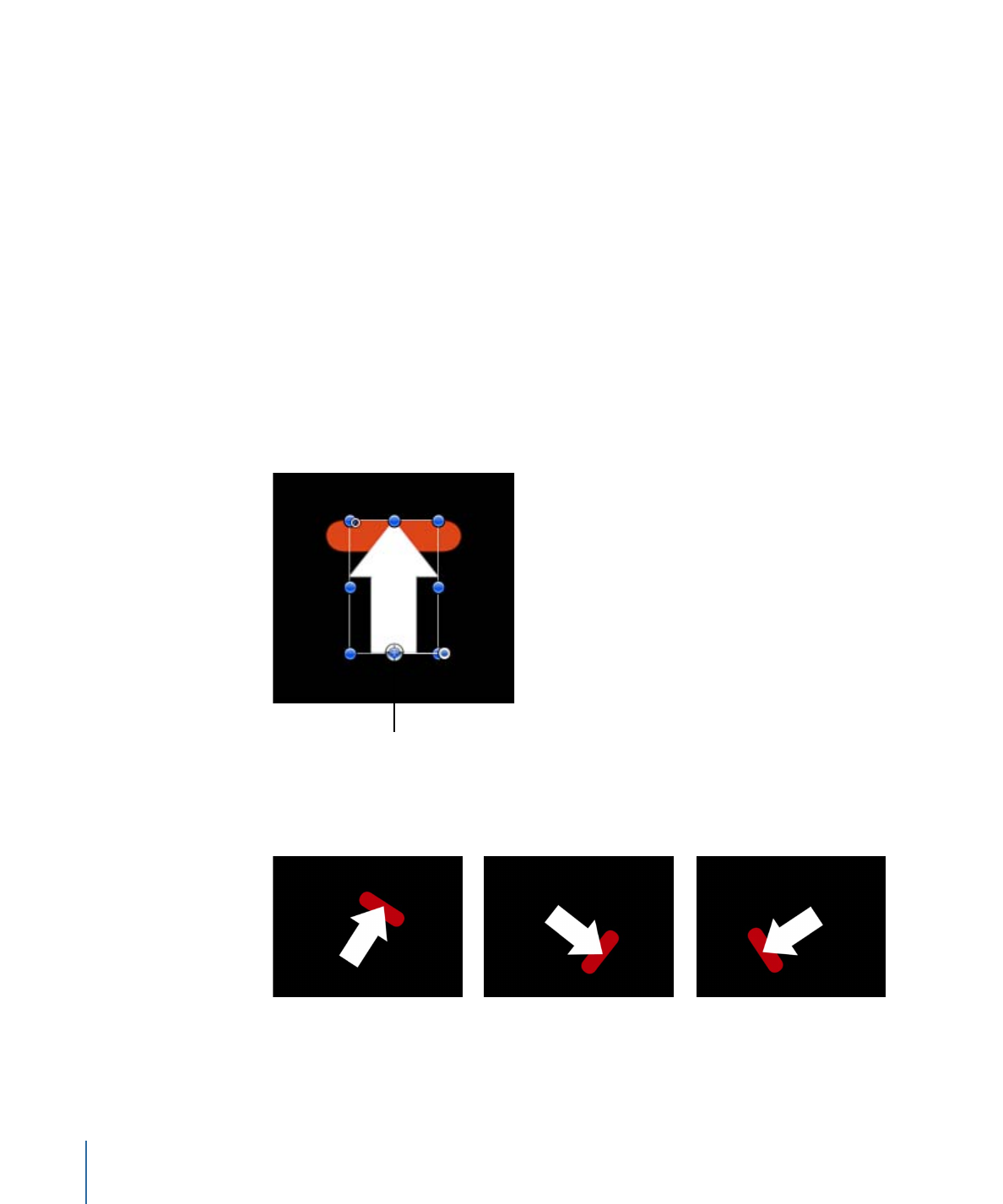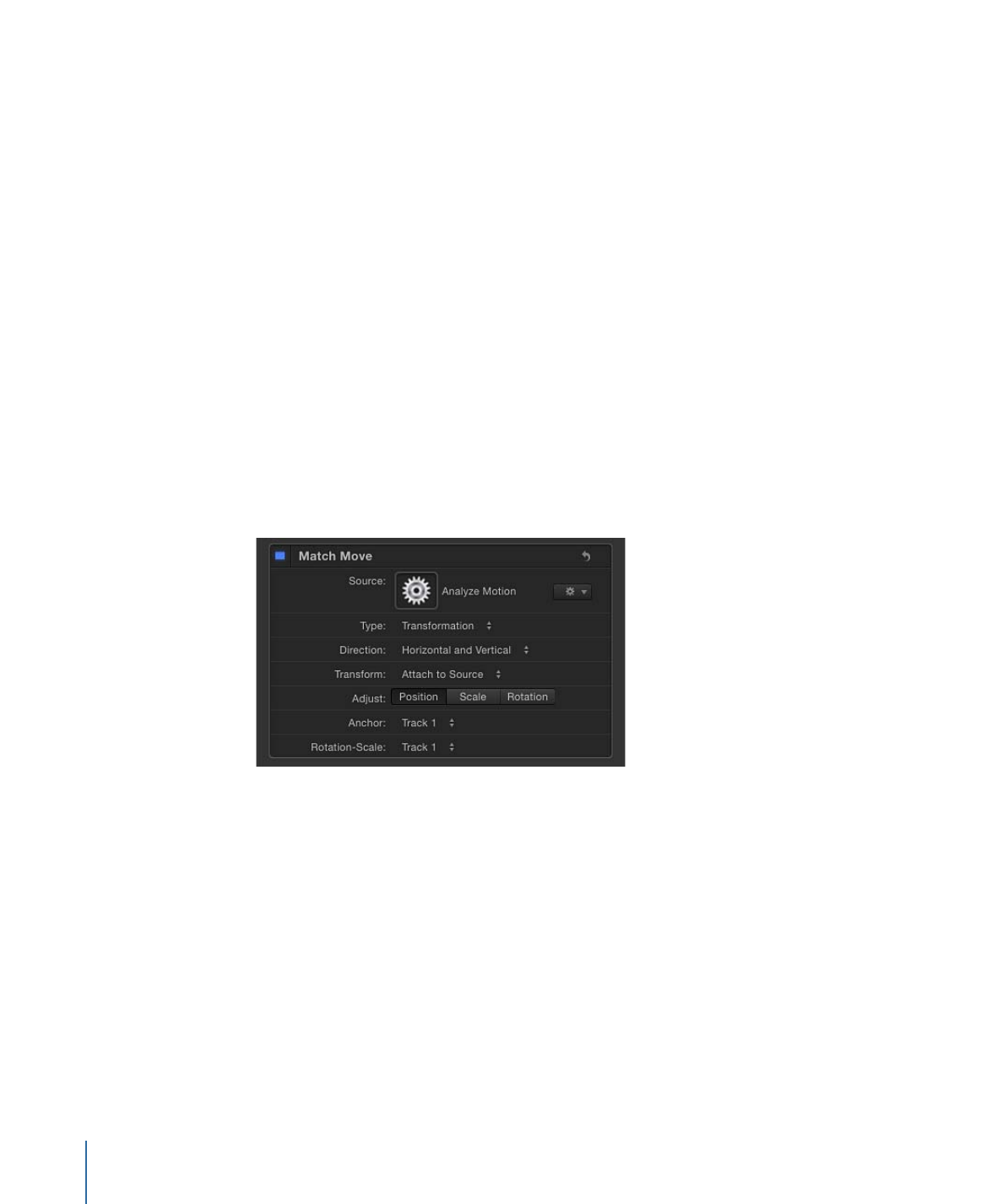
Match Move Controls
The Match Move behavior can be applied to many object types, including groups, cameras,
shapes, particle emitters, and so on.
Important:
When applying the Match Move behavior to a group, make sure the footage
being analyzed resides outside of the group being tracked.
To use Match Move (and access its parameters), your project must contain a foreground
and a background object. For information on using the Match Move behavior, see
Match
Move Workflows
.
Parameters in the Inspector
Source:
Drag the source object for the match move into this well. The source object can
be another tracking behavior, an animated object, or a footage object. When a Match
Move behavior is added to an object, the nearest animated object, recorded track, or
footage object beneath the behavior in the Layers list appears in this well. To clear a
Source well, drag the item away from the well and release the mouse button.
When any nonfootage object (such as a shape or mask) is dropped in the Source well,
the trackers are no longer available in Match Move.
1342
Chapter 22
Motion Tracking

Note: When the Match Move behavior is applied to a mask, the masked object is selected
as the source.
Action menu:
Choose from a list of tracking data (from other tracking behaviors) in the
project.
Movement:
The Movement parameters contain the Analyze and Reverse controls, which
appear when there is a tracking source (footage) in the source well.
• Analyze: Click the Analyze button to begin the motion tracking analysis. When you
click Analyze, a status window appears and displays the tracking progress. To stop the
analysis, click the Stop button in the status window or press Esc.
The start of the track is based on the current playhead position, rather than the start
of the behavior in the Timeline.
• Reverse: When the Reverse checkbox is selected, the clip is analyzed from the current
playhead position to the first frame of the clip (or the first frame of the tracking
behavior).
Note: You must move the playhead to the frame where you want to begin the reverse
analysis.
Type:
This pop-up menu allows you to choose between one-point, two-point, or four-point
tracking. There are two options:
• Transformation: This option allows one-point or two-point tracking, transforming the
destination object.
• Four Corners: This option enables four-point tracking, corner-pinning the destination
object. When this option is chosen, the Direction and Adjust parameters are no longer
available.
Important:
The Four Corners option is not available when Match Move is applied to a
3D group or a mask. To corner-pin a 3D group, select the Flatten checkbox in the Group
Inspector.
Direction:
This pop-up menu specifies the dimension in which the recorded movement
is applied to the destination object: Horizontal and Vertical (X and Y), Horizontal (only X),
or Vertical (only Y).
1343
Chapter 22
Motion Tracking

Transform:
This pop-up menu sets how the destination object (the object to which the
Match Move behavior is applied) moves. There are two options:
• Attach to Source: This option anchors the foreground object to the recorded track or
animation source. Use Attach to Source when the source object is scaling or rotating,
and you want the destination object to stick to a spot on the source object. Any
animation that existed on the destination object before applying the track can be
preserved by using the Adjust parameters (Position, Scale, and Rotation), available
when Transformation is chosen from the Type pop-up menu.
Note: Although the destination object is attached to the movement of the source
object, the position of the destination object can be changed (offset from the source
object).
In the following example, Match Move is applied to the red pill shape and uses the
animated white arrow as the source object. The white arrow has an applied Spin
behavior and is spinning in a clockwise direction. Additionally, the arrow’s anchor point
is positioned at the bottom of the arrow (at the opposite end from the tip).
Arrow’s anchor point
When Attach to Source is chosen from the Transform pop-up menu and Position and
Rotation are selected in the Adjust parameter row, the red shape is anchored to one
spot on the arrow (the tip, in this example) as it matches the movement of the arrow.
1344
Chapter 22
Motion Tracking

• Mimic Source: This option allows the destination object to mimic the recorded track or
animation source. Any animation that existed on the foreground object before applying
the track can be added to the track by selecting Position, Rotation, or Scale in the Adjust
parameters.
Note: As with Attach to Source, the position of the destination object can be changed
(offset from the source object). Additionally, the destination object can be scaled and
rotated.
In the following images, Mimic Source is chosen from the Transform pop-up menu and
Position and Rotation are selected in the Adjust parameter row. The red shape is not
locked to one spot on the white arrow, but rather mirrors the arrow’s animation.
Mimic Source allows you to transform a tracked object in the Properties Inspector. For
example, you can change the scale, position, or rotation of a corner-pinned object. Also
when using Four Corners, Mimic Source allows you to adjust the trackers without
adjusting the foreground image.
Adjust:
This parameter sets the type of transformation applied to the destination object.
• Position: When enabled, the position of the source (or background) object is applied
to the destination (or foreground) object, and the Anchor (position) tracker is turned
on.
• Scale: When enabled, the scale of the source (or background) object is applied to the
destination (or foreground) object. The source track must include scale data for this
parameter to have any effect. When Scale is enabled, the Rotation-Scale tracker is turned
on.
• Rotation: When enabled, the rotation of the source (or background) object is applied
to the destination (or foreground) object. The source track must include rotation data
for this parameter to have any effect. When Rotation is enabled, the Rotation-Scale
tracker is turned on.
Tracker Preview:
This preview area appears only when there is a tracking source (footage)
in the source well. Use the preview to see a magnified view of the tracking reference area
for the selected tracker. The preview updates as you adjust the position of the tracker in
the Canvas. You can also drag in the preview area to adjust the position of the tracker.
When dragging in the preview area, the image moves around the red crosshairs in the
preview and the tracker moves in the Canvas.
1345
Chapter 22
Motion Tracking

Offset Track:
This parameter appears only when there is a tracking source (footage) in
the source well. If a tracker’s reference point becomes temporarily hidden or goes off the
screen, this parameter allows you to select a different reference point that continues the
same tracking path as the original reference point. For more information on offset tracking,
see
Tracking Obscured or Off-Frame Points Using Offset Tracking
.
Auto-Zoom:
This parameter appears only when there is a tracking source (footage) in
the source well. Choose an option from this pop-up menu to set the magnification level
when positioning the tracker in the Canvas. This allows you to zoom in on the Canvas
when searching for an ideal tracking reference pattern. There are four choices: None, 2x,
4x, and 8x.
Auto-Zoom Mode:
This parameter appears only when there is a tracking source (footage)
in the source well. Choose an option from this pop-up menu to set the display of the
auto-zoomed tracker in the Canvas. There are three choices:
• Normal: Displays a normal pattern.
• Contrast: Displays the tracker pattern with contrast detection.
• Edge: Displays the tracker pattern with edge detection. The Auto-Zoom Mode applies
to trackers in the Canvas and does not appear in the Tracker Preview in the Behaviors
Inspector. When None is chosen from the Auto-Zoom pop-up menu, the Auto-Zoom
Mode setting has no effect.
Look Ahead Frames:
This parameter appears only when there is a tracking source (footage)
in the source well. This slider and value slider allow you to specify the number of future
frames to be analyzed by the tracker. In other words, you can direct the tracker to look
in a specific location for its reference point. This is useful for footage that contains
fast-moving objects, because the reference point can quickly get away from the tracker.
For more information on using Look Ahead Frames, see
Giving Motion a Hint by Looking
Ahead
.
Anchor/Rotation-Scale:
Available when one-point or two-point tracking is enabled (when
Transformation is chosen from the Type pop-up menu), these checkboxes turn the Anchor
and Rotation-Scale trackers on or off. The anchor tracker records position data. When
Position is enabled in the Adjust parameters, the Anchor tracker is turned on. Rotation
and scale data are recorded by using the relationship between the Anchor and
Rotation-Scale trackers. When Scale or Rotation is enabled in the Adjust parameters, the
Rotation-Scale tracker is turned on.
When the Match Move behavior references another behavior, such as Analyze Motion,
the Anchor tracker becomes the Anchor pop-up menu. Likewise, the Rotation-Scale tracker
(if there is one) becomes the Rotation-Scale pop-up menu.
1346
Chapter 22
Motion Tracking

Click the Anchor or Rotation-Scale disclosure triangles to reveal additional parameters:
• Position: Displays the X and Y positions of the tracker. The X position is the value slider
on the left; the Y position is the value slider on the right. Click the disclosure triangle
to display labeled position value sliders.
• Track Size: Use this slider to adjust (in pixels) the pattern search size for the tracker. As
you adjust the track size, the Tracker Preview is updated to show the new track size.
There is no visual change in the Canvas tracker.
To adjust the Track Size without exposing its parameters, Option-drag left in the Tracker
Preview area to reduce the track size; Option-drag right to increase the track size.
• Search Size: Use this slider or value slider to increase or reduce the tracker’s search area
size. In Motion, you do not specify the size of a search area when setting up trackers
in the Canvas. To change the default search size, use the slider or value slider. If Search
Size is set to 200 percent, the tracker’s search area is twice the default search area size.
• Fail Tolerance: This parameter defines the amount of tolerance for error, or confidence
value, of the track. In other words, it defines at what score the tracker determines it is
able to match a reference feature. When above the score, the tracker accepts the match.
When below the score, the tracker rejects the match. After the match is rejected, the
Fail Behavior kicks in.
• Fail Behavior: This pop-up menu specifies what happens if the track confidence value
falls below the Fail Tolerance amount. The following options are available:
• Smart Retry: The tracker attempts to find the reference pattern in a larger search area.
If the pattern cannot be found, the tracker switches to the Predict option. Smart Retry
is the default fail behavior.
• Stop: The analysis stops when the tracker loses the reference pattern. You can also
click the Stop button in the tracking progress dialog or press Esc to stop an analysis.
• Predict: The tracker predicts a new search area without creating keyframes until it
finds a match for the reference pattern. This is excellent for tracked objects that pass
behind foreground objects.
• Predict and Key: If a failure is detected, the tracker predicts the location of the keyframe
based on a vector of the last two keyframes, and continues tracking in the new area.
• Don’t Predict: The tracker remains in its position and searches for subsequent matches
as the clip’s frames progress. While searching for a match, the tracker does not create
keyframes.
• Use Existing Keyframes: The tracker uses existing keyframes. Use this option if you
manually create track position keyframes to guide the tracker. After manually adding
keyframes, return to the start frame and start the tracking analysis. If the tracker
cannot locate the track pattern, the manually created tracking keyframes are
referenced to guide the tracker.
1347
Chapter 22
Motion Tracking

• Color: Click or Control-click the color well to set a color for the onscreen tracker. You
can also click the eyedropper and select a color in the Canvas. The default tracker color
is red. When a tracker is selected, its center point is yellow and the border of its
magnified inset is the color set in the color well. To adjust the individual color channels,
including the tracker’s opacity, click the disclosure triangle.
Rotation-Scale (pop-up menu):
When the Match Move behavior references another
behavior, such as Analyze Motion, the Rotation-Scale tracker becomes the Rotation-Scale
pop-up menu. The tracker’s subparameters are replaced with a pop-up menu that allows
you to select the tracker from the referenced behavior you want to apply as the
Rotation-Scale tracker. By default, Track 2 is applied as the Scale-Rotation tracker. If there
is only one tracker in the referenced behavior, Track 1 is applied to both Anchor and
Rotation-Scale.
Anchor (pop-up menu):
When the Match Move behavior references another behavior,
such as Analyze Motion, the Anchor tracker checkbox becomes the Anchor tracker. The
tracker’s subparameters are replaced with a pop-up menu that allows you to select the
tracker from the referenced behavior you want to apply as the Anchor tracker. By default,
Track 1 from the referenced behavior is applied as the Anchor tracker. If there is only one
tracker in the referenced behavior, Track 1 is applied to both Anchor and Rotation-Scale.
When Match Move references another behavior, the trackers from the referenced behavior
are applied to the Match Move trackers.
Top Left:
Available when four-point tracking is enabled (when Four Corners is chosen
from the Type pop-up menu) and the Match Move behavior references another behavior
(such as Analyze Motion), this pop-up menu allows you to select the tracker from the
referenced behavior you want to apply as the top left tracker.
Top Right:
Available when four-point tracking is enabled (when Four Corners is chosen
from the Type pop-up menu) and the Match Move behavior references another behavior
(such as Analyze Motion), this pop-up menu allows you to select the tracker from the
referenced behavior you want to apply as the top right tracker.
1348
Chapter 22
Motion Tracking

Bottom Right:
Available when four-point tracking is enabled (when Four Corners is
chosen from the Type pop-up menu) and the Match Move behavior references another
behavior (such as Analyze Motion), this pop-up menu allows you to select the tracker
from the referenced behavior you want to apply as the bottom right tracker.
Bottom Left:
Available when four-point tracking is enabled (Four Corners is chosen from
the Type pop-up menu) and the Match Move behavior references another behavior (such
as Analyze Motion), this pop-up menu allows you to select the tracker from the referenced
behavior you want to apply as the bottom left tracker.
HUD Controls
The Match Move HUD contains controls to load an animated object or tracking data from
another tracking behavior (via the Source well or the tracking behaviors pop-up menu),
to start the motion analysis (via the Analyze button), to reverse the direction of the track
(via the Reverse checkbox), to offset the track (the Offset Track checkbox), to specify
whether the destination object is four-corner pinned (the Type pop-up menu), and to
choose what transform is applied to the destination object (via the Adjust parameter).